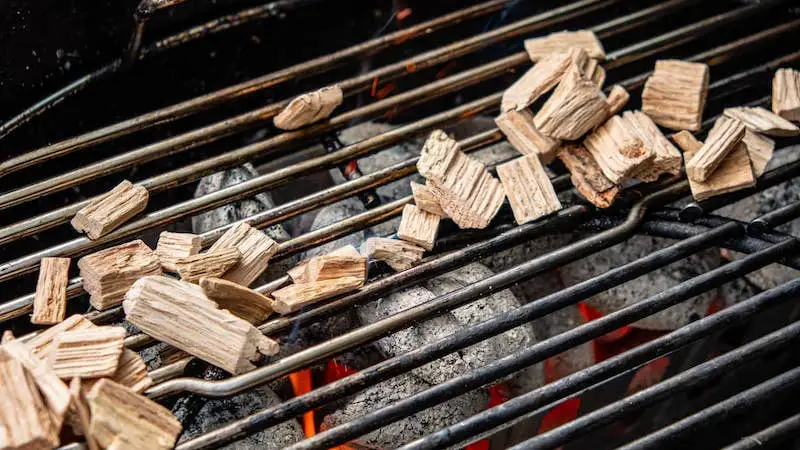There are many types of wood to choose from when you’re smoking or grilling food.
However, not all wood is the same, and certain types can result in bad-tasting food or, even worse, be toxic for human consumption.
So, how do you know what wood not to use for cooking? Don’t worry. This guide has you covered.
Keep reading to gain more in-depth knowledge on the types of wood you should avoid and which ones you should use instead.
Key Takeaway
Only use hardwoods to operate your smoker or grill. Avoid softwoods, unknown lumber, toxic, chemically treated, moldy, or freshly cut wood.
Stay Away From Softwoods
Softwoods are trees with needles or scale-like leaves that typically stay on the tree year-round. [1] Some examples include pine, fir, cypress, spruce, and cedar.
You shouldn’t cook food over softwoods for two main reasons.
First, they burn quickly as they’re less dense (contain more air). [1] This isn’t ideal as you want slow-burning wood for your grill or smoker.
Second, they have resin [2] — a syrup-like, natural substance produced by softwood trees that can impart an unpleasant taste to your food.
Don’t Use Woods Containing Toxins
Certain woods contain substances that are toxic to humans when consumed. When they’re burned, these same chemicals become airborne and can be inhaled.
Some toxic woods include:
Be Careful With Assorted Lumber
Lumber is ambiguous wood. Since it’s challenging to determine what kind of wood the lumber is, there’s no easy way to tell if it’s toxic to humans or likely to infuse the food with a weird flavor.
Pro Tip
Make sure you know the content of whatever you’re burning. It’s tempting to use spare lumber, but if you aren’t aware of the tree it came from, avoid using it for smoking.
Steer Clear of Chemical Treated Wood
Smoking your meat with chemically treated wood chemically treats your food as well. All of the chemicals in the wood go into the smoke and then into the meat.
These substances are often toxic and, at the very least, negatively alter the taste of the meat.
Wood pallets and scraps are usually chemically treated and should be avoided at all costs. Additionally, woods designed for outdoor use are treated to prevent mold and weather damage.
The Environmental Protection Agency lists the following as wood preservatives: [10]
- Chromated Arsenicals
- Pentachlorophenol
- Propiconazole
- Triadimefon
- Acid Copper Chromate
- Isothiazolinones
- Alkaline Copper Quaternary
- Borates
- Copper Azoles
- Copper Naphthenate
- Copper-HDO
- Polymeric Betaine
All of these substances are harmful to humans and should be avoided.
Avoid Moldy or Mildewed Wood
As the sustainability movement grows, more grillers want to use foraged wood to smoke their food. While the intention is admirable, scavenge with care.
Discarded wood grows mold and mildew under the right conditions: [11]
- A moist location
- On porous surfaces
- At temperatures between 60℉ and 80℉
Remember
Any substance on the wood you burn ends up in the meat you eat. Mold and mildew infuse the smoke and permeate the food.
Besides ruining the flavor of the meat, mold can be toxic.
Moldy wood causes issues even without ingesting contaminated meat. The act of burning the substance releases mycotoxins. [12] When these toxic chemicals spread through the air, they cause:
- Coughing
- Sneezing
- Eye irritation
- Throat irritation
Green Wood Isn’t Ideal
Your wood’s smoke seasons your food. Attaining the best flavors requires clean, dry wood. Freshly cut (AKA “green”) wood contains a lot of moisture.
The liquids in green wood become acrid smoke, infusing your food with a bitter taste.
Additionally, burning new, wet wood can release higher levels of creosote. Creosote is a noxious chemical that causes myriad adverse reactions in humans. [13]
Contact with the compound leads to:
- Rashes
- Skin irritation
- Chemical burns
- Convulsions
- Confusion
- Kidney problems
- Liver issues
In certain extreme cases, creosote contact leads to death.
What Woods Should You Use For Smoking?
Generally speaking, hardwoods provide a pleasant flavor and no side effects to food. Of course, as long as it doesn’t contain toxins, which I mentioned earlier in this guide.
Each wood provides a distinct taste to whatever is being cooked. Here are the best wood types to achieve your desired taste profile.
- Mild: If you are hoping to infuse your food with a mild taste, consider using alder, almond, apple, or cherry woods.
- Medium: For a medium smoky taste, use grape, maple, sarsaparilla, or pecan
- Strong: The following woods all contribute intense flavors to your food: oak, hickory, beech, or acacia.
- Very Strong: These woods release the strongest smoky flavors — pimento, walnut, or mesquite.
Frequently Asked Questions
Have more queries on what woods not to use for grilling or smoking? Check out the FAQ below.
Where Can You Buy Wood to Cook With?
You can buy wood to cook with at many hardware stores and online retailers. Also, don’t forget that you can use trees from your property as long as they’re safe.
How Long Should Wood be Seasoned For?
Wood needs to be seasoned (dried) for at least 1 year to achieve the best results for cooking food. Seasoning helps remove moisture from the wood, allowing it to impart better flavor.
Do You Need to Soak Wood Before Smoking?
No, you don’t need to soak wood before smoking because smoke won’t appear until the moisture is removed. The wood will heat up to water’s boiling point of 212°F and remain there until the water has evaporated.
Final Thoughts
You can’t just use any nearby log as firewood when cooking food or smoking meat. Some woods can impart unwanted flavors to your food, while others can be toxic.
So avoid softwoods and lumber that contain toxins. Instead, for best results, use hickory, mesquite, or oak that’s been dried out for at least 1 year.
